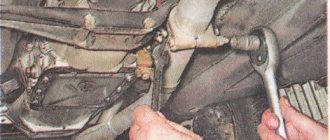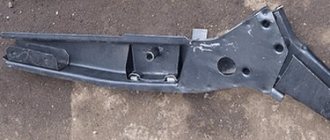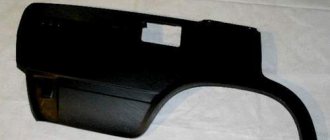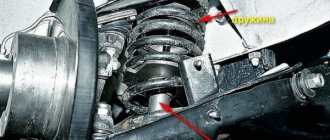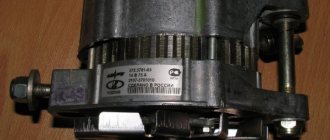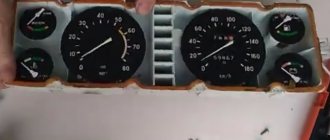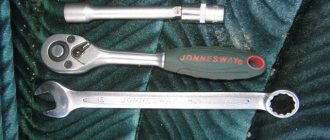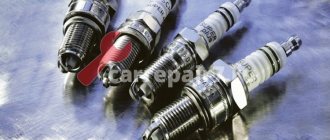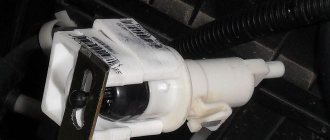The exhaust system of classic VAZ models consists of three elements. The middle element is usually called a resonator. Any malfunction is accompanied by a roar coming from under the bottom of the car. Repairing and replacing the resonator with your own hands is quite simple. In this case, the choice of a new part becomes especially important - the manufacturer installed several types of resonators on the VAZ 2107, depending on the type of engine and power system.
- Location of the VAZ 2107 resonator
- Choosing a resonator for VAZ 2107
Video: choosing a resonator for VAZ 2107
- Video: malfunctions of the exhaust system of classic VAZ models
- Video: replacing the VAZ 2107 resonator
Exhaust system design of VAZ 2107
- a receiving pipe into which gases enter from the exhaust manifolds;
- VAZ 2107 resonator (additional muffler), where gases are directed from the exhaust pipe and where the exhaust sound is partially reduced;
- muffler, which absorbs most of the engine exhaust noise.
- muffler mounting pad;
- pillow bolt;
- muffler suspension belt;
- clamp bolt and clamp securing the muffler to the resonator;
- clamp bolt and clamp securing the resonator to the exhaust pipe;
- clamp bolt and clamp securing the exhaust pipe to the body;
- nuts securing the exhaust pipe to the manifold;
- pad;
- locking plate;
Installation of an injection system on a VAZ 2107 required modernization of the exhaust system. Two additional details were added to it:
In connection with the installation of the catalyst, the VAZ 2107 resonator (injector) was moved a little back.
Advantages and disadvantages of the injection modification of the VAZ 2107
- thanks to the injector, the engine operates more stable in all modes;
- the specific power and torque of the injection engine are higher;
- the exhaust of a VAZ 2107 with an injection system is cleaner than smoke from a carburetor engine;
- Driving a car with an injection engine is easier, it is not so demanding on the driver’s qualifications and “forgiving” mistakes when operating the gas and clutch pedals.
- the clearance of the injection "seven" decreased to 7 cm, which worsened its cross-country ability;
- due to the installation of the catalyst, the “survivability” of the exhaust system has decreased;
- the high temperature of the catalyst sometimes causes grass and dry leaves to ignite when the car is stopped.
Major changes to components and assemblies
The modernized version of the VAZ 2107, which has an injector and an improved exhaust, has a number of advantages. The main advantages of the machine are as follows;
- The injector ensures high stability of engine parameters in different operating modes.
- The injection system increases specific power and torque, which adds dynamism to the car.
- During operation, the car's power unit produces less toxic emissions of CO and other compounds than its carburetor counterparts.
In practice, the operation of the machine is simplified for the driver; the injection system used is less demanding on the driver’s qualifications.
The matter was not limited to installing equipment for distributed injection on the VAZ 2107 car. The system, which ensures the exhaust of burnt gases, has also undergone serious modernization. A number of new elements have been added to it:
- A sensor was embedded in the exhaust manifold at the junction to determine the level of residual oxygen.
- A catalytic exhaust gas converter was installed under the bottom of the car in the central tunnel.
- This unit heats up to high temperatures during operation, and an additional steel screen was installed to protect the body and other parts.
- The resonator was shifted back in the direction of travel.
As a result, the exhaust system has become more complex, while reducing the toxicity of burnt gases. The injector allows you to regulate the specific amount of fuel in the mixture, reducing its consumption to a minimum.
Replacing the muffler VAZ 2107
- loosen the clamp bolt and remove (move) the clamp;
- pull the flared muffler pipe off the resonator (if that doesn’t work, knock it down with a hammer and chisel);
- remove the muffler from the cushion and mounting straps;
- install a new muffler on the VAZ 2107;
- tighten the clamp.
The VAZ 2107 resonator does not have fastening parts to the car body, so it is necessary to hold it when replacing it. Otherwise the exhaust pipe will be bent.
- tap clamps and pipe connections with a hammer;
- loosen the bolts of the clamps and move the clamps fastening to the “pants” and the muffler;
- disconnect the resonator from the muffler by undocking the pipes;
- disconnect the resonator from the receiving pipe (“pants”);
- install the new resonator in the correct position;
- connect the parts and tighten the fastening clamps.
Product delivery options
Note! Below are the shipping methods available specifically for this product. Payment options may vary depending on the shipping method. Detailed information can be found on the delivery and payment page.
Available payment methods:
- Using cards Sberbank, VTB, Post Bank, Tinkoff
- Yandex money
- QIWI
- ROBOKASSA
Delivery is possible to any locality where there is a representative office of the transport company. Delivery time is from 2 to 10 days. Sending large parcels is approximately 50% more profitable than by Russian Post.
- Cash upon receipt
- Using cards Sberbank, VTB, Post Bank, Tinkoff
- Yandex money
- QIWI
- ROBOKASSA
Delivery time from 1 to 12 hours.
- Cash upon receipt
- Credit
- Using cards Sberbank, VTB, Post Bank, Tinkoff
- Yandex money
- QIWI
- ROBOKASSA
Pickup times must coincide with store opening hours.
Direct flow on VAZ 2107 injectorLink to main publication
Related publications
- Lada Vesta sedan brown
Replacing the exhaust pipe (“pants”) of a VAZ 2107
- loosen the clamp and disconnect the pants from the resonator;
- unscrew the four nuts securing the exhaust pipe to the manifold;
- remove the “pants” (reception pipe) and gasket;
- install a new gasket;
- install a new exhaust pipe;
- connect the exhaust pipe to the resonator, tighten the fastening clamp;
- tighten the nuts securing the “pants” to the manifold.
- the resonator or exhaust pipe is fixed at the wrong angles;
- engine mounts sagged.
What will be required for replacement?
1) New resonator (other names: first stage muffler or additional muffler).
Aluminized Transmaster Universal stainless steel resonator. (double barrel)
Which resonator to choose: one or two tanks (barrels)? Single barrel or double barrel?
The first Zhiguli models were equipped with additional mufflers with one barrel, and on cars with a more powerful engine with a volume of 1.5, 1.6 liters (VAZ 2105, 2106, 2107) - double-barrel ones.
There is no particular difference in installing a resonator with 1 or 2 barrels; they are interchangeable and will fit any model, with the exception of the VAZ 2102, 2104 station wagons.
As for the noise level, an additional muffler with one barrel is considered a little noisier, but it gives a slight increase in power to the car (there is no additional exhaust resistance). Although the increase in this power is barely noticeable.
A classical resonator consisting of two “cans” is less noisy. Usually, the first can is a fire extinguisher.
2) Two metal clamps (44 mm - for the junction with the main muffler, 46 mm - for the junction with the exhaust pipe). Slightly larger clamps are also suitable, for example, with a diameter of 44.5 mm. and 48 mm.
Muffler clamp d44.5 mm and d48.5 mm
3) Graphite grease
4) Medium-grain sandpaper (sanding) 5) Wrenches for “7”, “13” mm. 6) Universal fluid WD-40 (“vd”, “vedeshka”) 7) Hammer, wooden spacer, screwdriver.
Exhaust System Mounting Parts
A clear understanding of the algorithm of actions when carrying out such an event as replacing a VAZ 2107 muffler will help every car enthusiast carry out his plans quickly and without errors. On the one hand, removing the old muffler and installing a new one seems simple, but on the other hand, you need to be prepared for some difficulties.
Why and how often is it necessary to change the VAZ 2107 muffler?
The exhaust system of a car, despite its relatively simple design, performs many functions. The main ones are:
- removal of fuel combustion products;
- significant reduction in exhaust sound level;
- maintaining air balance with the intake system;
- ensuring effective cleaning and ventilation of cylinders.
The VAZ 2107 muffler experiences enormous loads like no other part of the car. First of all, constant temperature changes have a destructive effect on the metal, which actively destroys not only the protective paint and varnish coatings, but also the structure of the metal itself.
Gases heated to a high temperature literally “eat up” the internal filling of the muffler, mixing with water condensate and oils, dissolving the metal walls, forming through corrosion. Externally, the muffler elements are also adversely affected by moisture, road sand and gravel; salt solutions in winter intensify the decomposition process.
As a result, after some time the driver can observe under the bottom of the car the pitiful remains of what was once called a muffler. Whether we like it or not, the muffler of a VAZ 21074 or any other model will have to be changed periodically. To the question of how often you should change the muffler, every car enthusiast must find the answer himself.
The service life of an exhaust system, like many others, depends on factors such as:
- activity of vehicle operation;
- quality of fuel used;
- the car owner’s attitude towards the condition of the car;
- frequency of use of the machine in adverse weather conditions;
- quality of previously installed exhaust system parts.
Having come to terms with the fact that the VAZ 2107 muffler will not last forever, you need to buy a new one and start replacing it.
Replacing the VAZ 2107 muffler - procedure
An inherently simple procedure can take a lot of effort and time. Before installing a new muffler, you must remove the old one. To do this you should:
- install the car on an overpass or above an inspection hole;
- prepare a set of tools, ensure good lighting under the machine;
- The muffler is connected by a pipe to the resonator pipe in front of the rear axle. The ends of pipes with a slot and a male-female connection are tightened from the outside with a coupling;
- Corrosion under the influence of lubricant and temperature can solder the joints so much that it becomes very difficult to remove them. It is better to moisten the pipes at the junction and the coupling in advance with a solution that corrodes corrosion. For this purpose, as a last resort, brake fluid or used oil is suitable.
The procedure for replacing the muffler is as follows:
- the crimp coupling is untwisted or cut off using a cutting tool (grinder) (in this case, a new coupling should be on hand);
- use a thin chisel or screwdriver to bend the flared edges of the pipe;
- the muffler is disconnected from the resonator (if it comes out tight, you can help yourself with a hammer by tapping on the pipe);
- hanging pillows are detachable. By the way, when buying a muffler, it is advisable to buy three suspension rubber bands (two in the center and one at the rear).
After this, the old muffler is in your hands and you can install the new one in the reverse order.
How to replace the muffler of a VAZ 21074 and other modifications of classics
Very often, car enthusiasts, seeing in the title of the article that the make of the car does not exactly match what is indicated in the registration certificate, continue to search for instructions. VAZ cars are charming because they differ from each other for the most part only in appearance, but the internal structure is completely identical.
It doesn’t matter what kind of car is in the garage: 2105, 2104, 2107 or 21074 - their exhaust system is completely the same. Having studied the repair instructions for one car, you can safely begin repairing another classic model.
Recommendations for tuning
Problems with the exhaust system, admittedly, occur quite rarely. But sometimes drivers need tuning. When remaking this unit, do not forget about the need to reprogram the ECU. If changes have been made to the design, then you need to inform him about it. Otherwise, interruptions will occur and the injector may behave inappropriately.
Many car owners like to install devices that change the exhaust sound. This is where your imagination can run wild. A device for every taste. You can make the car quiet, or you can turn your horse into a sports car. It will roar like at a race. Mostly young guys love such tricks. This does not bring any benefit to the car. Only the owner’s “rating” increases in the eyes of some public.
When to change the resonator
The resonator of any car is an additional muffler that reduces the noise level of the engine. In addition to the main “can,” the resonator, or as it is also called, receiving pipe can be equipped with an additional one.
Ultimately, holes appear on the surface of the resonator, which disrupt its operation. Exhaust gases escape through these defects, creating an unpleasant sound of the engine, which is not only unpleasant to others, but will certainly not leave traffic inspectors indifferent. That is why a damaged resonator must be replaced immediately.
To change the resonator, you need to stock up on all the necessary keys, kerosene or WD-40, as well as a lot of patience and accuracy. The fact is that high temperatures cause the exhaust pipe fasteners to melt, which subsequently makes it difficult to remove. In addition, you will need an inspection hole or overpass, otherwise changing the resonator will be very inconvenient.
Many automotive technicians suggest applying sealant before installing the exhaust system. Whether to do it or not is up to you. In any case, the reliability of fastening and sealing the exhaust system is limited only by the force that the clamp allows you to make.
Failure of the carrier unit
This often happens if the oxygen sensor is broken or malfunctioning. In addition, an attempt to start the car using a pusher may result in the destruction of the carrier unit. And its complete destruction can only happen under mechanical influence. Unfortunately, this can happen with an instantaneous change in temperature.
We drove into a puddle at high speed during the rain, cold water got onto the body, and the block was destroyed. The block carrier can become contaminated due to the fact that its cells become coked. This is usually caused by engine oil entering the combustion chamber and being released into the exhaust system.
see also
Comments 9
Is there any gasket between the resonator and the catalyst?
it seems no, there is a metal-graphite one before the catalyst, if I’m not confused
There were also injection sixes. If you have -2 euros, then you can also throw out the catalyst. Otherwise it sticks out and clings to everything.
I'm fine, it doesn't stick, mostly on asphalt. I didn’t even know about 6s
And there are holes on the asphalt))). On the Euro-3 jig, where the kat was not thrown out, the loaded one moved over a particularly prominent speed bump, and was hit by a can of kat so much that the middle steering rod had to be changed. Another friend of mine had the same problem. And when I took my four, at the first opportunity I threw out the cat and inserted the pipe.
“The donkey trampled and trampled, which should not have been done, because the trampling attracted Shai-Hulud, may the World be purified by his deed!”
>the article comes from the “six” My friend, “article”. >lubricated all the bolts with copper grease, and on top of that with graphite grease, just to be sure. It’s not worth it, really, it will be fine even with graphite... It looks like I seasoned the salad with sunflower oil, but I still dropped a little olive oil. In general, such cracks can be cooked and cooked, and you don’t need a new one, but it costs much less. Of course, if they’re brewed by weirdos, it won’t work for long... Thanks for the report!
The exhaust also needs to be changed, the resonator has holes...
Yes, it’s better to change in the summer than to freeze in winter or spend money on services
Exhaust system VAZ 2107 (carburetor)
Let's figure out what the muffler consists of. In the photo above:
- pillow bolt (1)
- cushion securing the muffler (2)
- main muffler (3)
- belt on which the muffler is suspended (4)
- clamp bolt (5)
- clamp securing the main muffler (muffler) to the resonator (6)
- bolt of the second clamp (7)
- clamp securing the resonator to the “pants” (8)
- nut securing the exhaust pipe to the exhaust manifold (9)
- locking plate (10)
- “pants” gasket (11)
- exhaust pipe (pants)(12)
- resonator (13)
- bolt of the clamp securing the exhaust pipe (14)
- clamp securing the exhaust pipe (15)
Muffler device (diagram)
The design of the muffler has already been partially discussed, now let’s delve deeper into the topic.
You probably already realized that mufflers have many distinctive features; no devices have the same design; each manufacturer introduces its own innovations to improve the design of its brainchild.
The main goal is to reduce the sound as much as possible without losing engine power.
In a typical production car, the muffler takes from 5 to 7% of the power. To achieve absolute silence, you need to either increase or install an additional device with a resonator, and this will take another 5 to 7% of the power. The total is 10–15%, which no one wants to lose.
Those. It turns out that it is not so easy to make an ideal muffler so that there is little noise and no loss of power.
The design of the product is largely influenced by:
- Engine capacity;
- Tuning or regular engine installed;
- Make of the car and its purpose (sports or regular);
- Who is the manufacturer.
The classic muffler for most cars consists of:
- Inlet and outlet pipes;
- Internal pipes;
- From two or more expansion chambers;
- Internal partitions;
- Helmholtz resonator.
The sound entering the device through the inlet pipe is reflected from the walls and travels a distance of more than 1 km, constantly weakening.
The resonator serves to weaken the most powerful component of the sound wave, which a conventional labyrinth cannot cope with.
The chambers in the muffler are of different sizes because the length of the sound waves is also different.
The inlet pipe, as a rule, has holes and is considered dissipative, since sound entering it is partially dissipated in the first chamber.
The waves move chaotically in space, reflecting from the walls and constantly losing energy. This occurs due to the force of friction against air molecules.
The more of the wave remains in the first chamber, the more the wave attenuates.
The remaining waves pass into the second scattering chamber; however, it is not easy for them to pass from a narrow pipe into open space since, according to the law of acoustics, a sound wave seems to collide with a wall of air.
Part of the wave is not able to enter the second chamber and is reflected back from the interface and partially absorbs the oncoming flow.
The same waves that were able to get into the second chamber are randomly reflected from the walls, absorbing each other and losing energy during friction with the air.
But the main component of the sound wave passes further and enters the Helmholtz resonator.
The sound wave again has to leave the narrow space into the free chamber, and it seems to press on the air in the resonator, creating air vibrations.
This creates a reverse sound wave that has the same frequency as the original one. They collide and destroy each other.
Some of the waves remaining in the second chamber enter another pipe and are transported to the third chamber.
There again, sound loss occurs due to friction with the air, and only after this the weakened wave enters the output pipe, and from there out.
How are knocking and muffler position related?
If the muffler suddenly starts knocking on some parts of the car, find the source of the extraneous sounds. Usually the reason lies in stretched rubber fasteners. After replacing them, the knocking will stop.
Sometimes a knock appears after work related to removing the muffler. In this case, extraneous sounds are a consequence of installation errors. Round pipes at the joints with clamps can be slightly rotated relative to the correct position: more or less than required, pushed into each other.
To eliminate knocking, restore the optimal position of the exhaust system elements.
Sagging mufflers can be “treated” using similar methods—by replacing rubber bands and correcting the position of joints.
